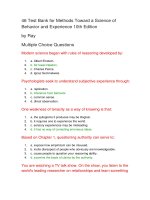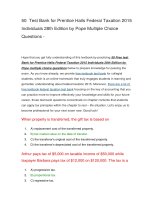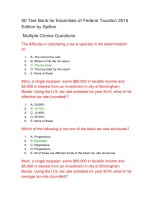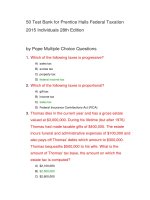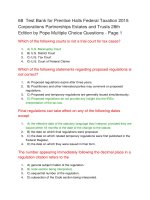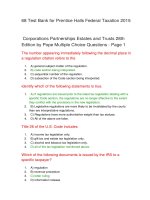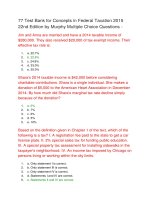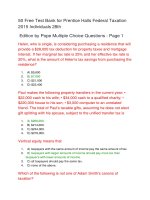152 test bank for south western federal taxation 2015 individual income taxes 38th edition
Bạn đang xem bản rút gọn của tài liệu. Xem và tải ngay bản đầy đủ của tài liệu tại đây (131.4 KB, 33 trang )
152 Test Bank for South Western Federal Taxation 2015
Individual Income Taxes 38th Edition
Multiple Choice Questions
Both economic and social considerations can be used to justify:
1.
a. Favorable tax treatment for accident and health plans provided for
employees and financed by employers.
2.
b. Disallowance of any deduction for expenditures deemed to be contrary to
public policy (e.g., fines, penalties, illegal kickbacks, bribes to government
officials).
3.
c. Various tax credits, deductions, and exclusions that are designed to
encourage taxpayers to obtain additional education.
4.
d. Allowance of a deduction for state and local income taxes paid.
5.
e. None of these.
Taxes levied by all states include:
1.
a. Tobacco excise tax.
2.
b. Individual income tax.
3.
c. Inheritance tax.
4.
d. General sales tax.
5.
e. None of these.
Which, if any, of the following statements best describes the history
of the Federal income tax?
1.
a. It did not exist during the Civil War.
2.
b. The Federal income tax on corporations was held by the U.S. Supreme Court
to be allowable under the U.S. Constitution.
3.
c. The Federal income tax on individuals was held by the U.S. Supreme Court
to be allowable under the U.S. Constitution.
4.
d. Both the Federal income tax on individuals and on corporations was held by
the U.S. Supreme Court to be contrary to the U.S. Constitution.
5.
e. None of these.
The U.S. (either Federal, state, or local) does not impose:
1.
a. Franchise taxes.
2.
b. Severance taxes.
3.
c. Occupational fees.
4.
d. Custom duties.
5.
e. Export duties.
Federal excise taxes that are no longer imposed include:
1.
a. Tax on air travel.
2.
b. Tax on wagering.
3.
c. Tax on the manufacture of sporting equipment.
4.
d. Tax on alcohol.
5.
e. None of these.
Burt and Lisa are married and live in a common law state. Burt wants
to make gifts to their four children in 2014. What is the maximum
amount of the annual exclusion they will be allowed for these gifts?
1.
a. $14,000.
2.
b. $28,000.
3.
c. $56,000.
4.
d. $112,000.
5.
e. None of these.
Indicate which, if any, statement is incorrect. State income taxes:
1.
a. Can piggyback to the Federal version.
2.
b. Cannot apply to visiting nonresidents.
3.
c. Can decouple from the Federal version.
4.
d. Can provide occasional amnesty programs.
5.
e. None of these.
Social considerations can be used to justify:
1.
a. Allowance of a credit for child care expenses.
2.
b. Allowing excess capital losses to be carried over to other years.
3.
c. Allowing accelerated amortization for the cost of installing pollution control
facilities.
4.
d. Allowing a Federal income tax deduction for state and local sales taxes.
5.
e. None of these.
Which, if any, of the following taxes are proportional (rather than
progressive)?
1.
a. State general sales tax
2.
b. Federal corporate income tax
3.
c. Federal estate tax
4.
d. Federal gift tax
5.
e. All of these
Which, if any, is not one of Adam Smith’s canons of taxation?
1.
a. Economy
2.
b. Certainty
3.
c. Convenience
4.
d. Simplicity
5.
e. Equality
Regarding proper ethical guidelines, which (if any) of the following is
correct?
1.
a. The use of client estimates in preparing a return may be acceptable.
2.
b. Under no circumstances should a question on a tax return be left
unanswered.
3.
c. If a client has made a mistake in a prior year’s return and refuses to correct it,
you should withdraw from the engagement.
4.
d. If the exact amount of a deduction is not certain (e.g., around mid-$600s), it
should be recorded as an odd amount (i.e., $649) so as to increase the
appearance of greater certainty.
5.
e. None of these.
A characteristic of FICA is that:
1.
a. It does not apply when one spouse works for the other spouse.
2.
b. It is imposed only on the employer.
3.
c. It provides a modest source of income in the event of loss of employment.
4.
d. It is administered by both state and Federal governments.
5.
e. None of these.
Allowing a domestic production activities deduction for certain
manufacturing income can be justified:
1.
a. As mitigating the effect of the annual accounting period concept.
2.
b. As promoting administrative feasibility.
3.
c. By economic considerations.
4.
d. Based on the wherewithal to pay concept.
5.
e. None of these.
The proposed flat tax:
1.
a. Would eliminate the income tax.
2.
b. Would simplify the income tax.
3.
c. Would tax the increment in value as goods move through the production and
manufacturing stages to the marketplace.
4.
d. Is a tax on consumption.
5.
e. None of these.
Which, if any, of the following provisions of the tax law cannot be
justified as promoting administrative feasibility (simplifying the task of
the IRS)?
1.
a. Penalties are imposed for failure to file a return or pay a tax on time.
2.
b. Prepaid income is taxed in the year received and not in the year earned.
3.
c. Annual adjustments for indexation increases the amount of the standard
deduction allowed.
4.
d. Casualty losses must exceed 10% of AGI to be deductible.
5.
e. A deduction is allowed for charitable contributions.
Which, if any, of the following provisions cannot be justified as
mitigating the effect of the annual accounting period concept?
1.
a. Nonrecognition of gain allowed for involuntary conversions.
2.
b. Net operating loss carryback and carryover provisions.
3.
c. Carry over of excess charitable contributions.
4.
d. Use of the installment method to recognize gain.
5.
e. Carry over of excess capital losses.
State income taxes generally can be characterized by:
1.
a. The same date for filing as the Federal income tax.
2.
b. No provision for withholding procedures.
3.
c. Allowance of a deduction for Federal income taxes paid.
4.
d. Applying only to individuals and not applying to corporations.
5.
e. None of these.
A characteristic of FUTA is that:
1.
a. It is imposed on both employer and employee.
2.
b. It is imposed solely on the employee.
3.
c. Compliance requires following guidelines issued by both state and Federal
regulatory authorities.
4.
d. It is applicable to spouses of employees but not to any children under age 18.
5.
e. None of these.
Taxes not imposed by the Federal government include:
1.
a. Tobacco excise tax.
2.
b. Customs duties (tariffs on imports).
3.
c. Tax on rent cars.
4.
d. Gas guzzler tax.
5.
e. None of these.
Characteristics of the “Fair Tax” (i.e., national sales tax) include
which, if any, of the following:
1.
a. Abolition of the Federal individual (but not the corporate) income tax.
2.
b. Abolition of all Federal income taxes but retention of payroll taxes (including
the self-employment tax).
3.
c. Abolition of all Federal income taxes and payroll taxes but retention of the
Federal estate and gift taxes.
4.
d. Abolition of all Federal income and payroll taxes as well as the Federal estate
and gift taxes.
5.
e. None of these.
A VAT (value added tax):
1.
a. Is regressive in its effect.
2.
b. Has not proved popular outside of the U.S.
3.
c. Is not a tax on consumption.
4.
d. Is used exclusively by third world (less developed) countries.
5.
e. None of these.
Which, if any, of the following transactions will increase a taxing
jurisdiction’s revenue from the ad valorem tax imposed on real
estate?
1.
a. A resident dies and leaves his farm to his church.
2.
b. A large property owner issues a conservation easement as to some of her
land.
3.
c. A tax holiday issued 10 years ago has expired.
4.
d. A bankrupt motel is acquired by the Red Cross and is to be used to provide
housing for homeless persons.
5.
e. None of these.
A use tax is imposed by:
1.
a. The Federal government and all states.
2.
b. The Federal government and a majority of the states.
3.
c. All states and not the Federal government.
4.
d. Most of the states and not the Federal government.
5.
e. None of these.
Which of the following is a characteristic of the audit process?
1.
a. Most taxpayer audits involve “special” agents.
2.
b. Self-employed taxpayers are less likely to be selected for audit than
employed taxpayers.
3.
c. Less important issues are handled by means of a correspondence audit.
4.
d. If a taxpayer disagrees with the IRS auditor’s finding, the only resort is to the
courts.
5.
e. None of these.
A landlord leases property upon which the tenant makes
improvements. The improvements are significant and are not made
in lieu of rent. At the end of the lease, the value of the improvements
are not income to the landlord. This rule is an example of:
1.
a. A clear reflection of income result.
2.
b. The tax benefit rule.
3.
c. The arm’s length concept.
4.
d. The wherewithal to pay concept.
5.
e. None of these.
Which, if any, of the following is a typical characteristic of an ad
valorem tax on personalty?
1.
a. Taxpayer compliance is greater for personal use property than for business
use property.
2.
b. The tax on automobiles sometimes considers the age of the vehicle.
3.
c. Most states impose a tax on intangibles.
4.
d. The tax on intangibles generates considerable revenue since it is difficult for
taxpayers to avoid.
5.
e. None of these.
In terms of probability, which of the following taxpayers would be
least likely to be audited by the IRS?
1.
a. Taxpayer owns and operates a check-cashing service.
2.
b. Taxpayer is an employed electrician.
3.
c. Taxpayer just received a $3 million personal injury award as a result of a
lawsuit.
4.
d. Taxpayer just won a $1 million slot machine jackpot at a Las Vegas casino.
5.
e. Taxpayer has been audited several times before.
A characteristic of the fraud penalties is:
1.
a. When negligence and civil fraud apply to a deficiency, the negligence penalty
predominates.
2.
b. Criminal fraud can result in a fine and a prison sentence.
3.
c. The criminal fraud penalty is 75% of the deficiency attributable to the fraud.
4.
d. The IRS has the same burden of proof in the case of criminal fraud than with
civil fraud.
5.
e. None of these.
Which, if any, of the following transactions will decrease a taxing
jurisdiction’s ad valorem tax revenue imposed on real estate?
1.
a. A tax holiday is granted to an out-of-state business that is searching for a
new factory site.
2.
b. An abandoned church is converted to a restaurant.
3.
c. A public school is razed and turned into a city park.
4.
d. A local university sells a dormitory that will be converted for use as an
apartment building.
5.
e. None of these.
Taxes levied by both states and the Federal government include:
1.
a. General sales tax.
2.
b. Custom duties.
3.
c. Hotel occupancy tax.
4.
d. Franchise tax.
5.
e. None of these.
Provisions in the tax law that promote energy conservation and more
use of alternative (non-fossil) fuels can be justified by:
1.
a. Political considerations.
2.
b. Economic and social considerations.
3.
c. Promoting administrative feasibility.
4.
d. Encouragement of small business.
5.
e. None of these.
Property can be transferred within the family group by gift or at death.
One motivation for preferring the gift approach is:
1.
a. To take advantage of the higher unified transfer tax credit available under the
gift tax.
2.
b. To avoid a future decline in value of the property transferred.
3.
c. To take advantage of the per donee annual exclusion.
4.
d. To shift income to higher bracket donees.
5.
e. None of these.
David files his tax return 45 days after the due date. Along with the
return, David remits a check for $40,000 which is the balance of the
tax owed. Disregarding the interest element, David’s total failure to
file and to pay penalties are:
1.
a. $400.
2.
b. $3,600.
3.
c. $4,000.
4.
d. $4,400.
5.
e. None of these.
True False Questions - Page 1
The Federal estate and gift taxes are examples of progressive taxes.
1.
True
2.
False
On transfers by death, the Federal government relies on an estate
tax, while states impose an estate tax, an inheritance tax, both taxes,
or neither tax.
1.
True
2.
False
The ad valorem tax on personal use personalty is more often avoided
by taxpayers than the ad valorem tax on business use personalty.
1.
True
2.
False
A safe and easy way for a taxpayer to avoid local and state sales
taxes is to make the purchase in a state that levies no such taxes.
1.
True
2.
False
Not all of the states that impose a general sales tax also have a use
tax.
1.
True
2.
False
States impose either a state income tax or a general sales tax, but
not both types of taxes.
1.
True
2.
False
Sales made by mail order are not exempt from the application of a
general sales (or use) tax.
1.
True
2.
False
The formula for the Federal income tax on corporations is the same
as that applicable to individuals.
1.
True
2.
False
Even if property tax rates are not changed, the amount of ad valorem
taxes imposed on realty may not remain the same.
1.
True
2.
False
The payasyougo feature of the Federal income tax on individuals
conforms to Adam Smith’s canon of certainty.
1.
True
2.
False
The Federal gas-guzzler tax applies only to automobiles
manufactured overseas and imported into the U.S.
1.
True
2.
False
Julius, a married taxpayer, makes gifts to each of his six children. A
maximum of twelve annual exclusions could be allowed as to these
gifts.
1.
True
2.
False
Under the usual state inheritance tax, two heirs, a cousin and a son
of the deceased, would not be taxed at the same rate.
1.
True
2.
False
In 2014, José, a widower, sells land (fair market value of $100,000)
to his daughter, Linda, for $50,000. José has not made a taxable gift.
1.
True
2.
False
One of the major reasons for the enactment of the Federal estate tax
was to prevent large amounts of wealth from being accumulated
within the family unit.
1.
True
2.
False
Mona inherits her mother’s personal residence, which she converts
to a furnished rent house. These changes should affect the amount
of ad valorem property taxes levied on the properties.
1.
True
2.
False
Two persons who live in the same state but in different counties may
not be subject to the same general sales tax rate.
1.
True
2.
False
The Federal excise tax on cigarettes is an example of a proportional
tax.
1.
True
2.
False
A Federal excise tax is no longer imposed on admission to theaters.
1.
True
2.
False
The first income tax on individuals (after the ratification of the
Sixteenth Amendment to the Constitution) levied tax rates from a low
of 2% to a high of 6%.
1.
True
2.
False
There is a Federal excise tax on hotel occupancy.
1.
True
2.
False
The Federal income tax on individuals generates more revenue than
the Federal income tax on corporations.
1.
True
2.
False
Currently, the Federal income tax is less progressive than it ever has
been in the past.
1.
True
2.
False
The ratification of the Sixteenth Amendment to the U.S. Constitution
was necessary to validate the Federal income tax on corporations.
1.
True
2.
False
Because the law is complicated, most individual taxpayers are not
able to complete their Federal income tax returns without outside
assistance.
1.
True
2.
False
Before the Sixteenth Amendment to the Constitution was ratified,
there was no valid Federal income tax on individuals.
1.
True
2.
False
A fixture will be subject to the ad valorem tax on personalty rather
than the ad valorem tax on realty.
1.
True
2.
False
Under Clint’s will, all of his property passes to either the Lutheran
Church or to his wife. No Federal estate tax will be due on Clint’s
death in 2014.
1.
True
2.
False
Like the Federal counterpart, the amount of the state excise taxes on
gasoline varies from state to state.
1.
True
2.
False
The FICA tax (Medicare component) on wages is progressive since
the tax due increases as wages increase.
1.
True
2.
False
An inheritance tax is a tax on a decedent’s right to pass property at
death.
1.
True
2.
False
One of the motivations for making a gift is to save on income taxes.
1.
True
2.
False
The annual exclusion, currently $14,000, is available for gift and
estate tax purposes.
1.
True
2.
False
82 Free Test Bank for South Western Federal Taxation
2015 Individual Income Taxes 38th Edition by
HoffmanTrue False Questions - Page 2
To lessen, or eliminate, the effect of multiple taxation, a taxpayer who
is subject to both foreign and U.S. income taxes on the same income
is allowed either a deduction or a credit for the foreign tax paid.
1.
True
2.
False
If more IRS audits are producing a greater number of no change
results, this indicates increased compliance on the part of taxpayers.
1.
True
2.
False
For Federal income tax purposes, there never has been a general
amnesty period.
1.
True
2.
False
For the negligence penalty to apply, the underpayment must be
caused by intentional disregard of rules and regulations without intent
to defraud.
1.
True
2.
False
The principal objective of the FUTA tax is to provide some measure
of retirement security.
1.
True
2.
False
If the tax deficiency is attributable to fraud, the negligence penalty will
not be imposed.
1.
True
2.
False
A parent employs his twin daughters, age 17, in his sole
proprietorship. The daughters are not subject to FICA coverage.
1.
True
2.
False
Under state amnesty programs, all delinquent and unpaid income
taxes are forgiven.
1.
True
2.
False
The value added tax (VAT) has not had wide acceptance in the
international community.
1.
True
2.
False
Jason’s business warehouse is destroyed by fire. As the insurance
proceeds exceed the basis of the property, a gain results. If Jason
shortly reinvests the proceeds in a new warehouse, no gain is
recognized due to the application of the wherewithal to pay concept.
1.
True
2.
False
If an income tax return is not filed by a taxpayer, there is no statute of
limitations on assessments of tax by the IRS.
1.
True
2.
False
Even though a client refuses to correct an error on a past return, it
may be possible for a practitioner to continue to prepare returns for
the client.
1.
True
2.
False
As a matter of administrative convenience, the IRS would prefer to
have Congress decrease (rather than increase) the amount of the
standard deduction allowed to individual taxpayers.
1.
True
2.
False
The amount of a taxpayer’s itemized deductions will increase the
chance of being audited by the IRS.
1.
True
2.
False
As it is consistent with the wherewithal to pay concept, the tax law
requires a seller to recognize gain in the year the installment sale
occurs.
1.
True
2.
False
For individual taxpayers, the interest rate for income tax refunds
(overpayments) is the same as that applicable to assessments
(underpayments).
1.
True
2.
False
In cases of doubt, courts have held that tax relief provisions should
be broadly construed in favor of taxpayers.
1.
True
2.
False
No state has offered an income tax amnesty program more than
once.
1.
True
2.
False
If a taxpayer files early (i.e., before the due date of the return), the
statute of limitations on assessments begins on the date the return is
filed.
1.
True
2.
False
A provision in the law that compels accrual basis taxpayers to pay a
tax on prepaid income in the year received and not when earned is
consistent with generally accepted accounting principles.
1.
True
2.
False
A major advantage of a flat tax type of income tax is its simplicity.
1.
True
2.
False
In preparing a tax return, all questions on the return must be
answered.
1.
True
2.
False
A tax cut enacted by Congress that contains a sunset provision will
make the tax cut temporary.
1.
True
2.
False
Various tax provisions encourage the creation of certain types of
retirement plans. Such provisions can be justified on both economic
and social grounds.
1.
True
2.
False
When Congress enacts a tax cut that is phased in over a period of
years, revenue neutrality is achieved.
1.
True
2.
False
When a state decouples from a Federal tax provision, it means that
this provision will not apply for state income tax purposes.
1.
True
2.
False
The civil fraud penalty can entail large fines and possible
incarceration.
1.
True
2.
False
In an office audit, the audit by the IRS takes place at the office of the
taxpayer.
1.
True
2.
False
A CPA firm in California sends many of its less complex tax returns to
be prepared by a group of accountants in India. If certain procedures
are followed, this outsourcing of tax return preparation is proper.
1.
True
2.
False
A state income tax can be imposed on nonresident taxpayers who
earn income within the state on an itinerant basis.
1.
True
2.
False
The IRS agent auditing the return will issue an RAR even if the
taxpayer owes no additional taxes.
1.
True
2.
False
The objective of pay-as-you-go (paygo) is to achieve revenue
neutrality.
1.
True
2.
False
To mitigate the effect of the annual accounting period concept, the
tax law permits the carryforward to other years of the excess
charitable contributions of a particular year.
1.
True
2.
False
Upon audit by the IRS, Faith is assessed a deficiency of $40,000 of
which $25,000 is attributable to negligence. The 20% negligence
penalty will apply to $25,000.
1.
True
2.
False
If a “special agent” becomes involved in the audit of a return, this
indicates that the IRS suspects that fraud is involved.
1.
True
2.
False
If fraud is involved, there is no time limit on the assessment of a
deficiency by the IRS.
1.
True
2.
False
The tax law provides various tax credits, deductions, and exclusions
that are designed to encourage taxpayers to obtain additional
education. These provisions can be justified on both economic and
equity grounds.
1.
True
2.
False
For state income tax purposes, a majority of states allow a deduction
for Federal income taxes.
1.
True
2.
False
During any month in which both the failure to file penalty and the
failure to pay penalty apply, the failure to file penalty is increased by
the amount of the failure to pay penalty.
1.
True
2.
False
The IRS is required to redetermine the interest rate on
underpayments and overpayments once a year.
1.
True
2.
False
In preparing an income tax return, the use of a client’s estimates is
not permitted.
1.
True
2.
False
Currently, the tax base for the Social Security component of the FICA
is not limited to a dollar amount.
1.
True
2.
False
On occasion, Congress has to enact legislation that clarifies the tax
law in order to change a result reached by the U.S. Supreme Court.
1.
True
2.
False
Stealth taxes have the effect of generating additional taxes from all
taxpayers.
1.
True
2.
False
For omissions from gross income in excess of 25% of that reported,
there is no statute of limitations on additional income tax
assessments by the IRS.
1.
True
2.
False
When interest is charged on a deficiency, any part of a month counts
as a full month.
1.
True
2.
False
Some states use their state income tax return as a means of
collecting unpaid sales and use taxes.
1.
True
2.
False
Unlike FICA, FUTA requires that employers comply with state as well
as Federal rules.
1.
True
2.
False
A calendar year taxpayer files his 2013 Federal income tax return on
March 5, 2014. The return reflects an overpayment of $6,000, and
the taxpayer requests a refund of this amount. The refund is paid on
May 16, 2014. The refund need not include interest.
1.
True
2.
False
Free Text Questions
For the tax year 2014, Noah reported gross income of $300,000 on
his timely filed Federal income tax return. a. Presuming the
general rule applies, when does the statute of limitations on
assessments normally expire? b. Suppose Noah inadvertently
omitted gross income of $76,000. When does the statute of
limitations on assessments expire? c. Suppose the omission
was deliberate and not inadvertent. When does the statute of
limitations on assessments expire?
Answer Given
a. Three years from April 15, 2015. b. If more than 25% of gross income is omitted, a
six-year statute applies (i.e., 6 years from April 15, 2015). Here, it does as $76,000 is
more than $75,000 (25% × $300,000). c. If fraud is involved, the statute never expires.
Morgan inherits her father’s personal residence including all of the
furnishings. She plans to add a swimming pool and sauna to
the property and rent it as a furnished house. What are some
of the ad valorem property tax problems Morgan can
anticipate?
Answer Given
The real estate taxes probably will increase for several reasons. The capital
improvements and the conversion from residential to rental will trigger the increase.
Furthermore, the furnishings may generate an ad valorem tax on personalty.
(Depending on applicable law, furniture might not be subject to tax unless used for
business purposes—such as in this case.)
What are the pros and cons of the following state and local tax
provisions? a. An ad valorem property tax holiday made
available to a manufacturing plant that is relocating. b. Hotel
occupancy tax and a rental car surcharge. c. A back-to-school
sales tax holiday.
Answer Given
a. Such a holiday is designed to attract new industry to the area. This means more
jobs and growth in consumption. On the other hand, if the tax holiday is too generous,
this places a strain on available public revenue. The result could be that schools and
capital maintenance (roads, public services) will suffer. b. The hotel occupancy tax and
car rental surcharges are popular because they mainly impact visitors. Also, they can
generate considerable revenue to finance major capital improvements. If these taxes
become excessive, however, they could discourage major events (such as
conventions). c. Such holidays are very popular with both merchants and consumers
and serve the social need of defraying some of the costs of sending children to school.
Once established, however, they are difficult to get rid of. Thus, they become an
annual drain on sales tax revenue.
Virtually all state income tax returns contain checkoff boxes for
donations to various causes. On what grounds has this
procedure been criticized?
Answer Given
In many cases the procedure is overused (i.e., a multiplicity of boxes). This overuse
adds complexity to the return. Also, in most cases the donation is being drawn from
any income tax refund that might be due. Thus, taxpayers may not fully appreciate that
they are paying for such checkoffs.
Under what conditions is it permissible, from an ethical standpoint,
for a CPA firm to outsource tax return preparation to a third
party?
Answer Given
First, the clients’ confidentiality must be preserved. Second, the CPA firm must verify
the accuracy of the work. Third, the clients must be advised as to the practice.
Tracy has just been audited and the IRS agent has issued an RAR
that assesses a large deficiency. Since Tracy disagrees with
the result, her next step is to go to court. Do you agree?
Answer Given
Tracy might save herself time and expense by going to the Appeals Division of the
IRS. Here, the IRS has the authority to negotiate a settlement based on the “hazards
of litigation” (i.e., the probabilities of winning or losing). If a settlement is reached,
resort to the courts is avoided.
How do the net operating loss provisions in the tax law mitigate the
effect of the annual accounting concept?
Answer Given
Without the allowance of carryback and/or carryover provisions that apply the excess
losses to profitable years, the losses would disappear. As shown by Example 24, this
result places a business with profit and loss fluctuations on a more level playing field
with one that maintains a stable income pattern.
Two months after the burglary of his personal residence, Eric is
audited by the IRS. Among the items taken in the burglary was
a shoe box containing approximately $50,000 in cash. Eric is
the owner and operator of a cash-and-carry liquor store. Eric
wonders why he was audited. Can you help explain?
Answer Given
Although Eric’s audit by the IRS could be the result of sheer chance, this appears
unlikely. Press coverage of the burglary, particularly if the items stolen were
enumerated, could have put the IRS on notice. Why would anyone keep such a large
amount of cash at his personal residence? Also, Eric is in a business where tax
evasion is easily accomplished.
What is a severance tax? How productive can it be in terms of
generating revenue?
Answer Given
A severance tax is one imposed when natural resources (e.g., oil, gas, iron ore, coal)
are extracted. It is based on the notion that the state has an interest in such resources.
For some states, the revenue from severance taxes can be significant. Alaska, for
example, relies heavily on its severance taxes and has been able to avoid both a state
income tax and a general sales tax.
In late June 2014, Art is audited by the state and a large deficiency is
assessed. In November of the same year, his Federal income
tax return is audited by the IRS. What has probably
happened?
Answer Given
The IRS has been notified by the state concerning the results of the June audit.
Your client, Connie, won $12,000 in a football office pool. She sees
no reason to include it in her income for several reasons. First,
the amount won will not be reported to the IRS. Second, as an
average income employee, she is unlikely to be audited by the
